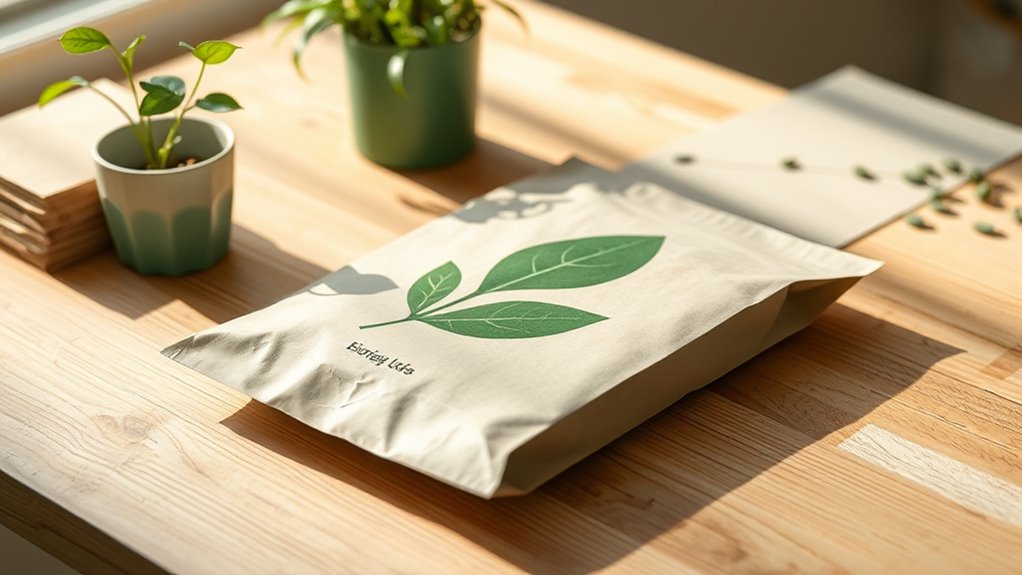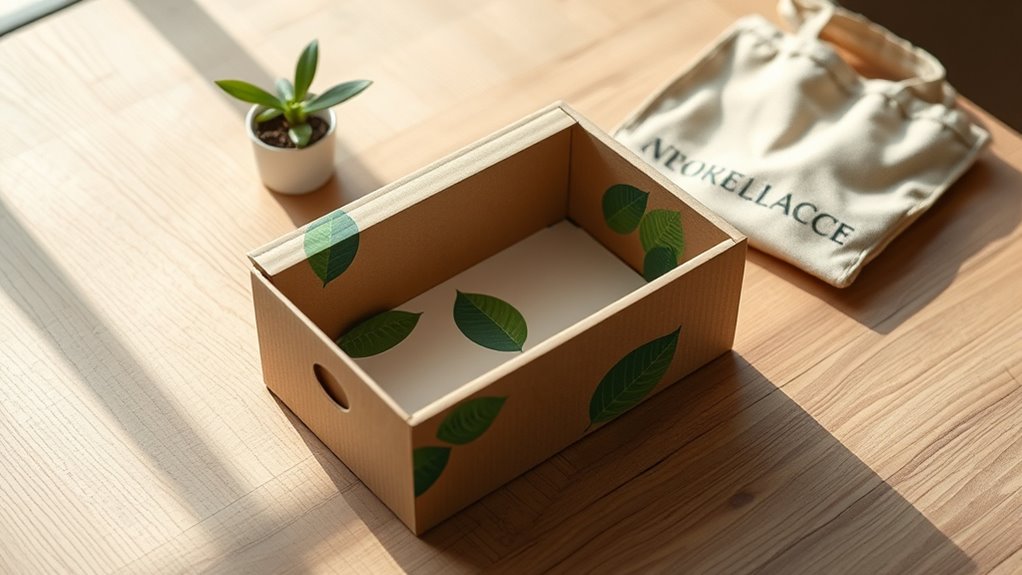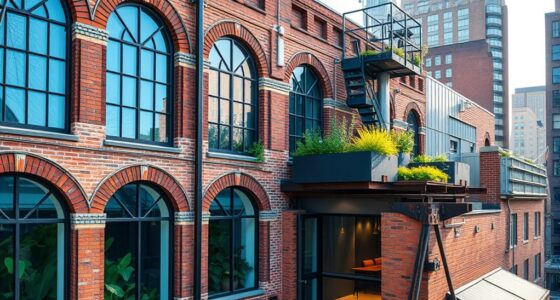To reduce waste from the start with sustainable packaging design, choose eco-friendly materials like biodegradable plastics, recycled paper, or plant-based fibers that break down naturally. Keep designs minimal and simple, which uses less ink and materials, making recycling easier. Focus on creating durable and reusable packaging that encourages customers to repurpose products, extending their lifecycle. If you want to explore innovative strategies to make your packaging more eco-conscious, there’s more to discover ahead.
Key Takeaways
- Use eco-friendly, biodegradable, and recycled materials to minimize environmental impact and facilitate easier recycling.
- Adopt minimalistic design with fewer layers, ink, and embellishments to streamline waste and enhance recyclability.
- Design packaging for reuse and durability, encouraging consumers to repurpose containers and extend their lifecycle.
- Incorporate simple visuals and logos that communicate sustainability without unnecessary decorations or coatings.
- Optimize material use through innovative design techniques to reduce waste and support sustainable supply chain practices.

Have you ever wondered how packaging can be both functional and environmentally friendly? It’s a question that’s becoming more important as consumers grow aware of waste and sustainability. The key lies in choosing the right materials and design approach from the start. Eco friendly materials are at the forefront of sustainable packaging. You can opt for biodegradable plastics, recycled paper, or plant-based fibers that break down naturally without polluting the environment. These materials reduce the reliance on virgin resources and lower your carbon footprint. But it’s not just about the materials you select; it’s also about how you present your brand. Minimalistic branding plays a vital role here. When you use simple, clean designs, you avoid excess ink, dyes, and decorative elements that can add to waste and complicate recycling. Minimalism doesn’t mean sacrificing aesthetic appeal; instead, it emphasizes clarity and purpose, making your packaging more recyclable and easier to process.
Incorporating eco friendly materials with minimalistic branding means you’re actively reducing waste from the outset. For example, using plain, uncoated kraft paper or cardboard with minimal printing can be both cost-effective and environmentally conscious. You can convey your brand identity through subtle, eco-themed visuals or a simple logo, avoiding unnecessary embellishments. This approach not only minimizes waste but also communicates your commitment to sustainability clearly to your customers. When you’re designing packaging, think about how it will be disposed of or recycled. Less is more—fewer materials, less ink, and fewer layers make the recycling process more efficient, ensuring that your packaging doesn’t end up in landfills or oceans. Additionally, considering Merkle trees in your supply chain data management can improve traceability and sustainability tracking. Implementing sustainable supply chain practices can further enhance your environmental impact and transparency. Leveraging innovative packaging design techniques can also help optimize material use and support reuse strategies.
Another way to reduce waste from the start is by designing for reuse. Packaging that’s durable and attractive can be repurposed by your customers, extending its lifecycle. Think of minimalistic, multi-purpose containers that can serve as storage or decorative items after their initial use. This strategy aligns perfectly with eco friendly principles, as it reduces single-use waste and encourages consumers to think twice before discarding packaging. Incorporating eco friendly materials alongside a minimalistic branding approach allows your packaging to serve both functional and environmental purposes, reinforcing your brand’s commitment to sustainability. By integrating eco friendly materials with a minimalistic branding approach, you create a packaging solution that’s not only functional but also sustainable. It’s about making thoughtful choices that prioritize environmental impact without compromising style or usability. Ultimately, reducing waste from the start means considering every element of your packaging—material, design, and end-of-life—so you can make a positive difference for the planet while still delivering an engaging, brand-appropriate experience.
Frequently Asked Questions
How Can Small Businesses Implement Sustainable Packaging Effectively?
You can implement sustainable packaging effectively by choosing eco-friendly materials that align with your brand values. Focus on packaging aesthetics to attract customers while reducing waste, which boosts brand loyalty. Educate your customers on your sustainability efforts and how they contribute to environmental preservation. Simple changes, like minimal packaging or recyclable options, can make a big impact. This approach not only appeals visually but also builds trust and loyalty with eco-conscious consumers.
What Are the Latest Innovations in Eco-Friendly Packaging Materials?
You’re curious about the latest innovations in eco-friendly packaging materials. Biodegradable plastics are gaining popularity, breaking down naturally and reducing landfill waste. Plant-based packaging, made from renewable resources like cornstarch or sugarcane, offers sustainable alternatives to traditional plastics. These innovations help you minimize environmental impact and appeal to eco-conscious consumers. By adopting these materials, you demonstrate your commitment to sustainability and stay ahead in eco-friendly packaging trends.
How Do Sustainable Designs Impact Product Shelf Life and Protection?
You might think eco-friendly designs compromise product durability and packaging integrity, but that’s not true. Sustainable packaging often enhances shelf life by using barrier materials that protect against moisture and oxygen. These innovative designs maintain product integrity while reducing waste. By choosing eco-conscious materials, you guarantee your products stay fresh longer, supporting both environmental goals and customer satisfaction. Sustainable designs positively impact product protection without sacrificing durability.
What Are the Cost Differences Between Traditional and Sustainable Packaging?
When comparing traditional and sustainable packaging, you’ll notice a cost difference primarily in material expenses. Sustainable options often have higher upfront costs due to eco-friendly materials, but they can save you money long-term through reduced waste disposal and brand value. The cost comparison varies depending on materials used and scale, but investing in sustainable packaging can lead to better environmental impact and potentially lower overall expenses over time.
How Can Consumers Identify Genuinely Eco-Friendly Packaging Options?
To identify genuinely eco-friendly packaging, look for clear recycling labels and biodegradable markers on the product. These indicators show that the packaging is designed for proper disposal and breaks down naturally. Avoid packages without recycling symbols or those made from mixed materials, which are harder to recycle. By paying attention to these cues, you can make more sustainable choices and support environmentally responsible brands.
Conclusion
By choosing sustainable packaging, you’re making a powerful impact from the very start. Every decision you make can reduce waste and protect our planet for future generations. Don’t you want to be part of the solution rather than the problem? Embrace eco-friendly design, innovate, and lead the way toward a cleaner, greener world. Remember, small changes today can create a lasting positive change tomorrow. Are you ready to make a difference?









